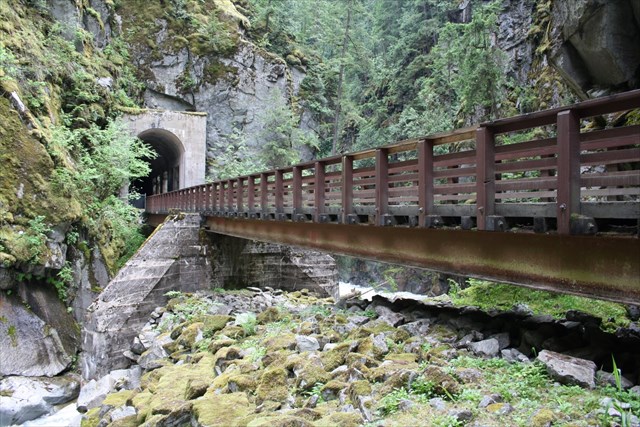The Othello Tunnels are a series of five tunnels originally built for railway access, and now part of the Trans Canada Trail system. The tunnels are constructed through native granite, with concrete and wood interior supports, connected in several areas by trestles. The tunnels are located on the old rail grade of the Kettle Valley Railway just north of Hope in southwestern British Columbia.

The Othello Tunnels are significant for their natural, historic, aesthetic and scientific values, particularly for their role in the early development of the province and for their technical achievement.
Originally constructed in 1914 for railroad use, the Othello Tunnels have significant natural history values for the opportunity they provide to observe and study the original metamorphic bedrock geology of the Coquihalla Canyon, while the granite cliffs form the primary construction material of the tunnels.

Historical value is found in the fact that the tunnels were built in the early era of railroad development in the province, at a time when newly discovered mineral resources and their extraction were fuelling the province’s growing economy. The tunnels were part of a southern railway route constructed by the Canadian Pacific Railway (CPR), called the Kettle Valley Railway (KVR). The KVR connected the west coast to the city of Nelson in the central Kootenay. There is historical value in the naming of the Othello tunnels after an adjacent railway station on the KVR line--all the stations were named after characters in William Shakespeare’s plays--and for early references to the tunnels and the railway as 'McCulloch's Wonder,' nicknamed for the chief engineer who designed them. The KVR line was in service until a major washout occurred in 1959; it was abandoned in 1961. The tunnels became part of Coquihalla Canyon Provincial Park's trail system in 1986.
The tunnels and the abandoned railway grade have scientific value for the significant technical engineering achievement of their construction, seen in the excavation of the tunnels themselves, the ingenuity of cliff ladders, suspension bridges and ropes that allowed workers access to the area, and in the concrete and wood supporting structures. The construction of the tunnels through solid rock in a straight line was CPR chief engineer Andrew McCulloch’s ingenious and unique engineering response to the canyon geology, while the Coquihalla River canyon necessitated the construction of connecting railway trestles between the tunnels.
The canyon itself is significant for its breathtaking immense scale, the sheer vertical walls, and spectacular views up and down the Coquihalla River and to the Cascade Mountains to the north. The canyon and tunnels engage all of the senses with the visual experience of passing through the tunnels and the canyon, the cool temperature and damp scents in the tunnels, and the sound of the swirling Coquihalla River below.
The tunnels express a continuum of time through the use of different construction materials such as wood, concrete, and stone. Aesthetic value is found in the design of the wooden support structure in Tunnel No. 1, the elaborate concrete columns in Tunnel No. 2, and the decorative concrete tunnel entrances.

The location of the Othello tunnels near the convergence of several historic trails--the Hudson's Bay Company brigade trail, the Dewdney Trail and the Hope-Nicola Valley Trail--has both historical and recreational importance. These early trails assisted in the opening up of the province for settlement and resource extraction beginning in the late 1840s. The Hope-Nicola Trail is now a popular hiking route.
Another cache located in the tunnel, this one should be much easier than the one in Tunnel #1 as it is a small, and the tunnel is much shorter than the first one.